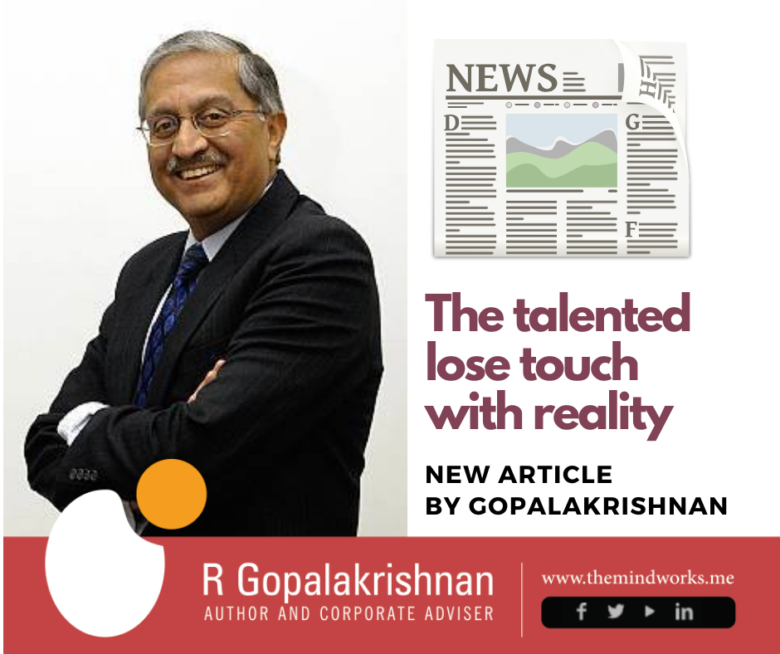07th July 2017, BUSINESS STANDARD
By R. Gopalakrishnan, Author, Corporate Advisor and Distinguished Professor of IIT Kharagpur, Email : rgopal@themindworks.me
As I write my 50th Innocolumn for Business Standard, I reflect on the soft side of innovation and entrepreneurship. . Entrepreneurs are like the repeat Everest climber, George Mallory, who when asked why he persisted, replied, “Because it is there.” So it is with entrepreneurs; they feel an irresistible urge! Success-seeking entrepreneurs behave child-like: curious-humble-intuitive-learning and determined. Stories of common people like us are instructive because their daily grind becomes visible, their anxieties, self-doubt and irrational determination are all palpable. Here are two stories.
Ramanujan : An indigent Tamil from Kumbakonam arrived in Bombay in the 1930s. His modest job with a local steel trading firm catapulted him into oil tank construction. In the early 1950s, he set up on his own. For a Marwari lad to do so would have been normal, but for a Tam Bram, the act was extraordinary! His company had its ups and downs over the next five decades, but it still flourishes. His grandson, Anand Raghavan, captured the human emotions of the family journey :
“My grandfather was advised to temper risk and ambition, but he would say, “I arrived with one dhoti and, if required, I will return with one dhoti”. Fearlessness faces adversity more elegantly than a failed risk assessment. Work fulfilled my grandfather’s spirit, money was a collateral for distribution–our home had a stream of villagers, seeking financial assistance. Nobody left empty handed”.
In the 80s, external events caused the company to go bankrupt. The family rearranged its spending. The telephone was cut for almost a year. When Anand was an engineering student, his friend’s father would visit Bangalore and stay at the Taj, MG Road. However Anand’s father, Babu, stayed at the Woodlands Hotel, where Anand would meet him in a spartan room. Babu stood quietly, sending Anand only love as a response to his dejection that his father could not afford the Taj.
Anand says, “My father worked with the quiet resolve required to travel through the landscapes of failure. His simplicity, courage and contentment enabled him to. Qualities that money can neither buy nor defeat.”
Sanghavi: A young Yash Sanghavi inherited Rs 30,000 when his father died with absolutely no knowledge of the family business of engineering. It was a near-death experience, which caused him to reflect and take risks. “When you have little to lose, you just have to take some risk,” said Yash Sanghavi enigmatically.
Yash Sanghavi has an unobtrusive personality. His behavior makes him appear as a natural connector with people. He built a network of professional contacts with purchasing managers in important chemical-oriented companies. He started travelling abroad. Some business success followed. As mentioned in the Ramanujan story above, and as is the social custom in Indian families, indigent relatives and friends would request help from the better-off relations. A modestly successful Yash entertained requests for help as far as he could handle them.
Yash had developed good business relations with Kyowa Hokko. The head of marketing in Asia, Raymond Goh, repeatedly said, “Biologics is important and vital for future medicine”. As a result of this comment, culturing, fermentation and natural chemicals began to interest a curious Yash. His knowledge gap set his curiosity on fire. Yash stumbled on to the potential of stem cells. A South Korean company, Sewon Cellontech, agreed to license their technology to him.
For Yash the building blocks came together miraculously. He was personally curious; his son acquired an MSc degree abroad in stem cells, and he assembled biotech experts who learnt stem cells, like Dr Vinayak Kedage, a PhD in tissue culture! In 2007, Regenerative Medical Services Private Limited (RMS) was born.
RMS describes itself as “the leading biotech company, focused on the delivery of the most advanced cell therapy treatments.” The company aims to be “the first in the world to offer bone and cartilage cell therapies.”
Cell-based therapeutics and stem cell bioprocessing repair bone and cartilage cells in a natural way. Suitable cells are extracted from the patient, brought to Lonavala, where they are multiplied, and then sent back for injection into the suffering patient. Developing the cell multiplication technology in India, perhaps the first in the world, clearing all regulatory requirements, and commercializing the product and service, all pursued with determination!
Lesson: As the late CK Prahalad pointed out, growth requires that ambition should exceed resources. These stories exemplify CK’s point. Growth, innovation and entrepreneurship are intertwined as a spaghetti. It takes curiosity, humility, intuition, learning and determination to untangle the spaghetti.

